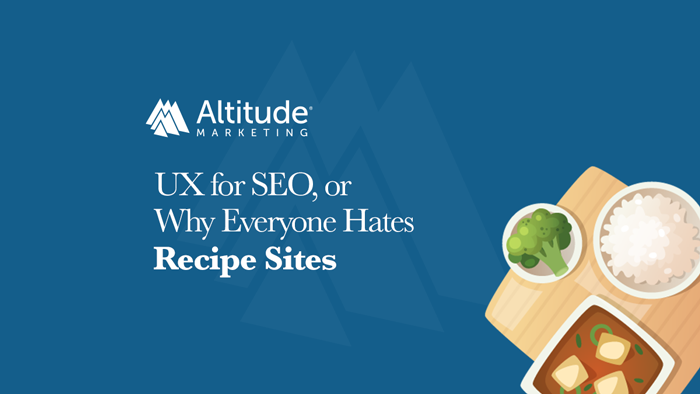Google’s search algorithm is one of the most incredible things ever invented by man. (The Saturn V couldn’t learn, after all.) And it’s getting better every day.
The algorithm (and the personalized SERPs it creates) focuses increasingly on user experience. In this post, we’ll break down why UX is the most important ranking factor on Google. And we’ll point out the weakest part of what the algorithm delivers, along with a bold prediction for 2021.

UX for SEO: Why It Matters
Googling something is a lot like asking a friend for a restaurant recommendation.
Your friend wants to send you somewhere you’re going to have a good, consistent experience. They don’t want to risk the place being closed or serving you a crappy meal. If that happens, you’re not asking them again.
In other words, bad experience = go somewhere else.
Now, think about Google.
The Mountain View giant isn’t going to have the best year for ad revenue. (Retail and travel getting shut down will do that to you.) But it still pulls in $30-odd billion from search advertising each year.
Why does it have search advertisers?
Because it has users.
Why does it have users?
Because it delivers consistent, high-quality results that offer a great user experience.
Now, let’s put that all together:
Google has billions of reasons to give better SERP ranks to sites that deliver a better UX.
UX as an SEO Ranking Factor
Of course, there’s no single way to quantify “user experience.” It’s a combination of dozens, or hundreds, of factors.
While we’ll never know exactly what’s in the algorithm, we do know that Google looks at:
- E-A-T, or experience, authority and trustworthiness. Is your site a credible source for information on a topic? Do others point their readers to you?
- Performance. This isn’t just speed anymore. Now, it’s Core Web Vitals. In particular, those focus on load time, time to interactivity and visual stability. (In other words, don’t pop in late ads that shift your content.)
- Readability. Yes, typos and college-level language will penalize you. (Unless the intent of the search is to find college-level language.)
- Mobile experience. Even if you run a B2B site with 5% mobile traffic, Google barely cares about your desktop site.
- Accessibility. Everyone should be able to enjoy your content, regardless of disabilities or impairments.
This all breaks down into one thing: UX.
A site that’s quick, written by experts and great on every device offers a good experience. And that’s what Google wants!
Big picture: Forget the SEO “tricks” and “hacks” you used to use. No amount of keyword stuffing or meta-tagging is going to improve your UX. (It might actually hurt it.) Just deliver a great experience every time, and the rankings will come.
Ugh, Recipe Sites
That discussion of UX for SEO brings us to the single weakest set of search results on Google.
You know what I’m talking about.
Recipe sites.
Recipe sites.
Everyone reading this has Googled a recipe. No matter how it turned out, I can pretty much guarantee everyone reading this got frustrated.
To wit, I just looked up a simple tofu recipe. Toss, add to hot pan, remove, eat. It doesn’t take long to explain this process.
And yet, here’s what I found on a top result. Buckle up.
- An author bio at the top of the page
- Six “recommended” recipes in the sidebar, including two for meat on a tofu recipe
- A huge picture
- A sticky advertising footer
- A sticky ad sidebar under the recommendations
- A story about her kids loving the recipe.
- A 300×250 rich media ad
- Tofu facts
- Another photo running 1,000 pixels down the page
- A video of the author’s latest recipe. For turkey meatballs.
- (There are ads after the meat video.)
- FINALLY ingredients. In a tiny bullet list. Followed by …
- Another photo running 1,000 pixels down the page
- Frequently asked questions about tofu, containing at least the page’s fourth reference to tofu’s lack of flavor
- An actually useful section on cutting tofu into cubes, with the page’s first worthwhile images
- (The meat video, and its ads, are now autoplaying in the bottom right corner of my browser. I can make a whole chicken in an Instant Pot.)
- A rich media ad
- Instructions for cutting tofu into cubes, in a tiny bullet list
- A six-image collage on “how to make fried tofu.” No context, but we’re getting there. The video’s for beef chili now.
- A 300×250 rich media ad. Serie A is back!
- INSTRUCTIONS FOR MAKING PAN FRIED TOFU
- (Still no ingredient measurements, though.)
- Another photo running 1,000 pixels down the page. Looks good. I WONDER HOW TO MAKE IT.
- A rich media ad
- “What To Serve Pan Fried Tofu With”
- “More Healthy Meat Free Dinner Recipes”
- THE ACTUAL RECIPE (with only two more ads)
Look: You can’t blame the blogger here. The recipe looks pretty tasty! Plus, they – and thousands of other recipe site owners – cracked the Google code in the bad old days. Google loves context. And imagery. And related content, linked prominently. This site certainly has that.
It’s also a UX nightmare.
So why the heck does it rank so high?
The Exception Proving the Rule
Only because Google hasn’t gotten to it yet.
Dramatic shifts in the algorithm are no easy thing. Disreputable medical and financial sites existed for years before Medic wiped them out. You can already start to see the shifts away from Recipe Hell ranking so well:
- Google is pulling key elements (e.g., ratings, time to cook and ingredients) from structured data. They’re right on the SERP – no need to access the page. In other words, Google doesn’t want you have to suffer to find the basics.
- Ads on the page were shifting content post-load. This runs specifically counter to Web Vitals guidance, which only came out in 2020.
- Everybody despises recipe sites. Google doesn’t make its money giving users what they hate.
Bold prediction: Google is going to find a way to ding these types of recipe sites by the end of 2021. They’re operating on an old paradigm, before UX and SEO became synonymous.
Instead – soon – you’re going to see sites that offer the recipe high on the page rank higher. They’ll load fast and give you what you want. There will be ads; it’s the web. But they won’t shift content post-load. This type of recipe site will gain traction, and the current crop will fade.
UX & SEO for B2B Sites
Sure, Adam. Everybody hates recipe sites. What does that have to do with B2B UX and SEO?
Glad you asked!
Recipe sites are about to be a cautionary tale. What ranks today ranks … today. If you build your house on a foundation of sand, it’s going to crumble someday. And the specific points that Google rewarded yesterday aren’t going to be rewarded tomorrow.
Think back to the initial point: the 30 billion reasons Google has to focus on UX above all else. Until it decides it doesn’t like money, Google is going to reward a solid user experience.
You can already see the beginnings of shifts in the recipe site world. The status quo won’t last long there. Neither will your rankings if you’re not treating user experience as the core of your SEO strategy.
Tips for Improving UX for SEO
- Develop in AMP-friendly templates whenever possible. It’s blazing fast on mobile, and forces you to avoid unnecessary elements on desktop, too.
- Get to the freakin’ point in your content.
- Write at a sixth-grade level, max. (Hemingway will guide you. This post is a fourth-grade level, FWIW.)
- Test your site with Lighthouse and get everything “in the green.”
- If it feels unnatural, don’t do it. Your users don’t want a sales pitch. They want information. Give it to them.
tl;dr
Across most categories, Google is rewarding user experience above all else. It’s giving developers tools to make them better, and alluding to UX across the board. And that makes sense! Better UX on sites that rank high means more users, which means more advertisers.
No, it’s not universal … yet. But read the tealeaves. The few segments where bad UX is still tolerated will change soon.
So take a look at your site’s user experience. If it’s sub-par, start working on it now – even if your rankings are good. Thirty billion-odd bucks are tough to argue with.



